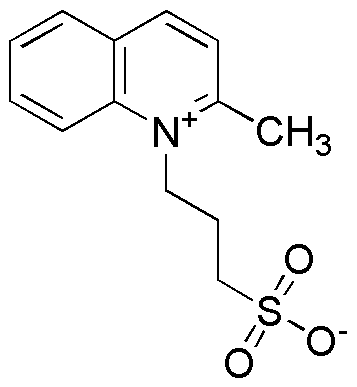2-Methyl-1-(3-sulphonatopropyl)quinolinium is widely utilized in research focused on:
- Biological Imaging: This compound serves as a fluorescent probe, enabling researchers to visualize cellular structures and processes in live cells, enhancing the study of cellular dynamics.
- Drug Delivery Systems: Its unique properties allow for the development of targeted drug delivery systems, improving the efficacy of pharmaceuticals while minimizing side effects in treatments.
- Environmental Monitoring: The compound can be employed in detecting pollutants in water sources, providing a reliable method for environmental scientists to assess water quality.
- Antimicrobial Applications: It demonstrates potential as an antimicrobial agent, making it valuable in the formulation of disinfectants and antiseptics for healthcare settings.
- Material Science: Used in the synthesis of advanced materials, it contributes to the development of functionalized polymers and coatings with enhanced properties for various industrial applications.
General Information
Properties
Safety and Regulations
Applications
2-Methyl-1-(3-sulphonatopropyl)quinolinium is widely utilized in research focused on:
- Biological Imaging: This compound serves as a fluorescent probe, enabling researchers to visualize cellular structures and processes in live cells, enhancing the study of cellular dynamics.
- Drug Delivery Systems: Its unique properties allow for the development of targeted drug delivery systems, improving the efficacy of pharmaceuticals while minimizing side effects in treatments.
- Environmental Monitoring: The compound can be employed in detecting pollutants in water sources, providing a reliable method for environmental scientists to assess water quality.
- Antimicrobial Applications: It demonstrates potential as an antimicrobial agent, making it valuable in the formulation of disinfectants and antiseptics for healthcare settings.
- Material Science: Used in the synthesis of advanced materials, it contributes to the development of functionalized polymers and coatings with enhanced properties for various industrial applications.
Documents
Safety Data Sheets (SDS)
The SDS provides comprehensive safety information on handling, storage, and disposal of the product.
Product Specification (PS)
The PS provides a comprehensive breakdown of the product’s properties, including chemical composition, physical state, purity, and storage requirements. It also details acceptable quality ranges and the product's intended applications.
Certificates of Analysis (COA)
Search for Certificates of Analysis (COA) by entering the products Lot Number. Lot and Batch Numbers can be found on a product’s label following the words ‘Lot’ or ‘Batch’.
*Catalog Number
*Lot Number
Certificates Of Origin (COO)
This COO confirms the country where the product was manufactured, and also details the materials and components used in it and whether it is derived from natural, synthetic, or other specific sources. This certificate may be required for customs, trade, and regulatory compliance.
*Catalog Number
*Lot Number
Safety Data Sheets (SDS)
The SDS provides comprehensive safety information on handling, storage, and disposal of the product.
DownloadProduct Specification (PS)
The PS provides a comprehensive breakdown of the product’s properties, including chemical composition, physical state, purity, and storage requirements. It also details acceptable quality ranges and the product's intended applications.
DownloadCertificates of Analysis (COA)
Search for Certificates of Analysis (COA) by entering the products Lot Number. Lot and Batch Numbers can be found on a product’s label following the words ‘Lot’ or ‘Batch’.
*Catalog Number
*Lot Number
Certificates Of Origin (COO)
This COO confirms the country where the product was manufactured, and also details the materials and components used in it and whether it is derived from natural, synthetic, or other specific sources. This certificate may be required for customs, trade, and regulatory compliance.


